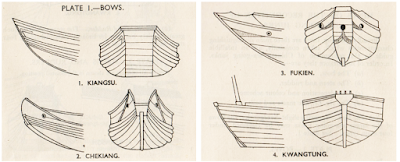Classic Wooden Fishing Boats of the Vietnamese Coast: Their Design, Construction, Rigging and Fisheries
by Ken Preston
2019
328 pages
Vietnam Women’s Publishing House, Ha Noi
ISBN 978-604-56-7858-9
When Ken
Preston served in the US Army in Vietnam, he saw little of the country’s vernacular
boats. But decades after the US withdrawal and the end of the war, he travelled
back to Vietnam for pleasure and was fascinated by the variety of boats he
saw and their methods of construction. Starting in 2005, he returned year after
year, spending weeks at a time traveling the country on a small motorcycle,
taking thousands of photos of boats and boatyards, and talking to boatbuilders
and fishermen. His book, Classic Wooden Fishing Boats of the Vietnamese Coast, is
the result, and a fine one it is.
The book is
organized unconventionally but with an undeniable logic. The very brief first
chapter, “Wooden Boats and Nautical Culture in Vietnam, Past and Present”, is
more like a second Introduction, barely mentioning thousands of years of boat
history prior to the middle of the 20th century. From that time
forward, though, it describes how the local fleet was documented by French
colonial observers and, later, by the US government, and how it changed rapidly
to leave behind much of its traditional roots and adopt larger, more
Western-like designs and diesel engine power.
The book
really hits its stride in Chapter 2, “Vietnamese Wooden Boat Designs,” which
describes the basic structure of traditional wooden fishing boats, some of
which are still in use, and contrasts it to the structure of newer, larger “modern
fishing vessels” (MFVs). The latter, although constructed plank-on-frame by
methods not dissimilar to Western methods, are still different enough in design
from Western vessels to be of interest. The chapter also discusses how
traditional and modern methods are sometimes combined, and shows how even
fairly large boats are built in temporary and ad-hoc shipyards with a minimum
of tools and infrastructure. The building sequences for both types of vessels
are described and illustrated in good detail.
 |
| A boatbuilder fitting the port side planks of a traditional fishing boat. The fully-assembled side will later be lifted and attached to the already-framed bottom, visible in the background. |
Chapter 3, “Seagoing
Baskets,” looks at small fishing boats where part or all of the hull is formed
of split bamboo basketwork. Some readers may be familiar with Vietnam’s iconic
round basket boats that may be paddled, rowed or – surprisingly often – powered
with small outboard or even inboard engines (see previous post on round basket boats). Less well known are small canoe-shaped basket
boats with light bamboo gunwales (see previous post for more on these narrow basket boats) and larger, oval-hulled
basket boats built with heavy rectangular frameworks of full-round bamboos around
their top perimeter, many with cabins, also of basketwork (see previous post on round basket boats of Tonkin Bay). Then
there are even larger, heavier open boats, almost indiscernible from
plank-built boats due to the substantial strakes that sheath their topsides (see cover image at top).
 |
| These large, round basket boats have inboard engines. Boats like this are used both for beach fishing and as dinghies for larger fishing boats. |
Chapter 4, “Boat
Building techniques” takes the reader step-by-step through the main procedures of
wooden hull construction, with excellent detail on tools and tool-use
techniques. Chapter 5, “Modern Fishing Gear on the Vietnamese Coast”, describes
the many methods of fishing practiced, including drift nets, seines, lift- or
dip-nets (called “push aheads” due to their mounting on the bow of boats), longlines,
squid gear, and more. Preston describes which boat types employ which types of gear
and the basics of their use.
Comprising just
shy of half the book’s page count, “A Trip Up the Coast: From Phu Quoc Island
to Mong Cai” is the final chapter. It is a valuable “moment-in-time”
record of boat building facilities and fishing boat use in dozens of major and
minor fishing ports. Because Preston visited some of the ports numerous times
over the course of years, he has sometimes documented the pace of change
and shown how quickly Vietnam is developing in some areas.
Classic
Wooden Fishing Boats of the Vietnamese Coast is a lovely, coffee-table size volume, produced entirely
in color, and wisely formatted in landscape mode, which is by far the better
choice for presenting photos of boats and ships. Preston’s photos are lively
and colorful, and most do an excellent job illustrating the matter at hand. For
the few that don’t come up to that standard, anyone familiar with photographing
industrial workplaces will acknowledge that ideal composition and lighting can
be elusive, and Preston has done a fine job working in challenging conditions. One
must admire his dedication to the project and the opportunities he made for
himself to hang around boatyards and gam with builders and fishermen. He has
produced a valuable body of ethnographic data that captures fishing and boatbuilding practices as they were during the early 21st century and will never be again.
Given its
value to vernacular boat students and enthusiasts, it is unfortunate that Classic
Wooden Fishing Boats of the Vietnamese Coast is so difficult to obtain. It was
published only in Vietnam and never properly distributed in the West. One hopes
a Western publisher will pick it up someday or that it will be made available
by other means.





















